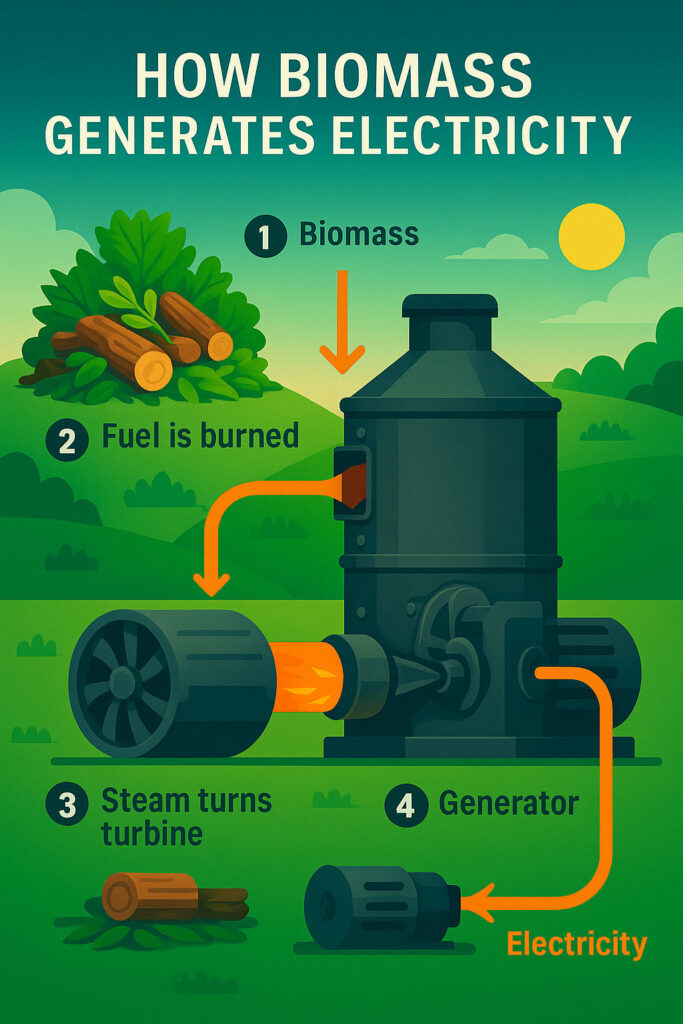Key Takeaways
- Biomass comes from organic materials that can be replenished, but its sustainability depends on responsible sourcing and land management.
- It supplies about 5% of total U.S. energy and roughly 1% of electricity, making it a modest yet reliable part of the renewable mix.
- Biomass turns wood scraps, crop residues, and organic waste into usable power and fuels while reducing landfill impact.
- Emerging technologies like carbon-capture biomass plants and advanced biorefineries could make it a bigger player in a low-carbon future.
In the simplest terms: biomass energy is energy derived from organic matter, things that were once living (plants, trees, agricultural residues, even waste) or things that continue to be “bio-based” (manure, landfill gas, etc.). According to the National Renewable Energy Laboratory (NREL), wood is the largest biomass energy resource in the U.S., and other sources include food crops, non-woody plants, forestry residues, and organic components of municipal and industrial waste.
Why does this matter? Because unlike ancient fossil fuels (coal, oil) that took millions of years to form, biomass comes from the short‐term carbon cycle: plants grow, absorb CO₂, you convert the biomass to energy, and in a properly managed system this can help keep things closer to “carbon‐neutral”. (We’ll come back to that nuance later.)
In everyday life, many uses of biomass pre-date modern electricity, wood burning for heat or cooking, agricultural residues for fuel, etc. But today it’s also used for electricity, heat, biofuels, and biogas systems.
Kinds of biomass
- Solid biomass: wood, wood wastes, crop residues, grasses.
- Liquid biofuels: for example ethanol or biodiesel from biomass feedstocks.
- Gaseous biomass / biogas: for example landfill gas, digester methane from manure/organic waste.
So, when we talk “biomass energy”, it can mean a lot of things, for heat, electricity, transportation fuels, or combined uses.
How Electricity from Biomass is Generated

Most biomass power plants work a lot like traditional fossil-fuel plants. The main difference is what goes into the boiler.
- Biomass such as wood chips or crop residues is collected and prepared by drying or pelletizing.
- The fuel is burned in a boiler to create steam.
- The steam drives a turbine that turns a generator to make electricity.
- The electricity is then sent to the power grid.
Some systems also use combined heat and power (CHP), which captures waste heat for industrial use or local heating systems. This makes the process more efficient overall.
Other technologies include anaerobic digestion, where microbes break down organic waste and produce methane gas that can be burned for power. Gasification and pyrolysis are more advanced techniques that convert solid biomass into gases or liquids before using them for electricity. Some coal plants also “co-fire” biomass to reduce emissions.
One advantage of biomass is that it can be used whenever needed. Unlike wind or solar, which depend on the weather, stored biomass can provide steady, on-demand electricity.
If you want to generate electricity from biomass, there are several technological routes; I’ll walk you through the core method and then touch on variations.
Why biomass for electricity is interesting
- It can be dispatchable, unlike wind or solar which depend on weather, biomass can be stored (in some sense) and used when you choose.
- It uses organic waste/residues, which adds value to what otherwise might be disposal or waste streams.
- It links to rural/forest/agricultural economies (feedstock sourcing).
Of course, all of this comes with cost, logistics, supply chain, environmental considerations, we’ll get to that.
Advantages & Disadvantages of Biomass Energy
Let’s talk about the pros and cons, because biomass is neither perfect nor negligible; it has strong potential, but also some real challenges.
Advantages
- Renewable: As long as the biomass resource (trees, crops, residues) is managed sustainably (i.e., regrowth, residue harvesting, not deforestation), biomass is a renewable resource.
- Waste reduction / resource efficiency: Biomass systems can make use of forestry residues, agricultural by‐products, municipal organic waste, landfill gas, so you’re capturing energy from materials that might otherwise decompose or be landfilled.
- Dispatchable energy: Biomass plants can in many cases operate on demand (or be ramped) in a way some renewables cannot.
- Local economic benefits: Feedstock sourcing, plant operation, rural jobs, forest management, biomass has the potential to benefit local economies.
- Potential for lower carbon impact (if done well): Because the carbon released by burning biomass (in principle) is roughly equal to what the biomass absorbed during growth, the net carbon footprint can be much lower than fossil fuels, though in practice the full lifecycle matters a lot.
Disadvantages / Challenges
- Feedstock supply & logistics: Gathering, transporting, storing biomass feedstock is typically more complex (and expensive) than simply using coal or gas. Biomass feedstocks often have lower energy density, higher moisture, more variability.
- Land use / sustainability concerns: If biomass harvesting is not managed well (leading to deforestation, soil degradation, biodiversity loss), then the environmental benefits can be eroded or lost.
- Air emissions: While biomass can reduce some fossil‐carbon emissions, the combustion process still emits CO₂, NOx, particulate matter, volatile organic compounds, depending on technology and fuel quality.
- Efficiency / cost: Some biomass systems are less efficient (i.e., lower conversion efficiency) and higher cost than other renewables (wind/solar) or fossil fuels, depending on context.
- Competition with other uses: Biomass feedstocks might compete with other uses (food, animal feed, industrial uses) or ecosystem services (carbon sequestration in forests).
- Carbon-payback timing: Even if you plant trees to replace harvested biomass, there is a time lag until those trees regrow and reabsorb the carbon, during which you might have elevated emissions. Some critics point this out.
- Scale limitations: There are practical limits on how much biomass you can sustainably harvest, transport, convert without causing undue environmental or social impact.
Overall biomass is a legitimate part of a renewable energy portfolio, but it must be done thoughtfully, sustainably, and with awareness of trade-offs.
Biomass in the U.S.: The Numbers
Biomass is a modest but important part of America’s renewable energy mix. It provides about 5% of total primary energy when including biofuels and heat. For electricity generation alone, biomass makes up roughly 1% to 1.5% of the U.S. power supply.
In 2023, the largest share of biomass energy came from biofuels like ethanol and biodiesel, followed by wood and wood waste. Smaller portions came from landfill gas, agricultural by-products, and municipal waste.
Most biomass power plants are located in regions rich in forests or agricultural activity. The Southeast, including states like Georgia, Florida, and Virginia, has seen the fastest growth in biomass electricity. States such as Maine rely heavily on wood-based biomass due to abundant forest resources.
Beyond electricity, biomass is widely used for industrial heat, residential heating, and transportation fuels, which together account for the majority of biomass energy consumption in the country.
Areas with the Largest Use of Biomass
Regions with large forestry or agricultural industries lead the nation in biomass use.
- Maine generates a significant share of its electricity from wood and paper mill residues.
- Georgia and Florida use wood pellets and forestry by-products in large-scale power plants.
- Iowa and North Dakota use agricultural waste for both electricity and biofuel production.
- California also uses a mix of forestry waste, crop residues, and landfill gas for renewable energy.
These states benefit from having abundant natural feedstocks close to where the power is produced, reducing transportation costs and supporting local jobs.
Future Potential & Interesting Developments
The future of biomass lies in smarter technology and better sustainability practices. New approaches like bioenergy with carbon capture and storage (BECCS) could make biomass a source of negative emissions by storing the carbon released during power generation.
Other innovations include more efficient conversion methods like gasification and advanced bio-refineries that produce multiple products, electricity, fuels, and valuable chemicals, from a single feedstock.
Biomass can also play an important supporting role in the power grid. Because it can generate electricity on demand, it complements intermittent renewables like wind and solar.
The biggest hurdles are ensuring sustainable sourcing, reducing costs, and proving that large-scale biomass use can truly reduce emissions over time. Policymakers and energy companies are watching these developments closely as part of the broader push toward carbon neutrality.
Interesting facts & nuances
- Biomass was the dominant energy source in the United States until the mid-1800s, before coal became widespread.
- The U.S. currently has more than 600 biomass power plants operating nationwide.
- Biomass exports, especially wood pellets, are a growing U.S. industry, with much of the material sent to Europe for use in renewable power plants.
- When paired with modern controls and carbon capture, biomass could one day help offset emissions from other sectors that are harder to decarbonize.
What could hold biomass back (and what to watch)
- If feedstock becomes more scarce or expensive (transport, collection, competing uses) the economics may weaken.
- Sustainability certification / ensuring that biomass sourcing does not cause unintended environmental harm will be critical.
- Competing technologies such as solar + wind + storage costs continue to fall, biomass must find its niche (for dispatchable power, waste conversion, combined heat & power, negative emissions) rather than just replicating what cheaper renewables already do.
- Policy shifts like incentives for biofuels, for biomass electricity, or carbon removal will shape how much biomass grows.
Why This Matters for You
Whether you’re a policy-maker, business stakeholder, engineer, student, or just someone curious about sustainable energy, understanding biomass energy gives you insight into a resource-rich, flexible, but complex part of the renewable landscape. If you’re in a region with agricultural residues, forest industry by-products, or a strong wood-products economy, biomass might be a locally meaningful tool in supporting energy, economic, and climate goals.
FAQs About Biomass
What is biomass energy?
Is biomass energy renewable?
How does biomass generate electricity?
What are common sources of biomass?
How much of U.S. electricity comes from biomass?
Is biomass energy good for the environment?
What are the advantages of biomass energy?
What are the disadvantages of biomass energy?
Where is biomass energy used the most in the U.S.?
Can biomass help fight climate change?
What’s the future of biomass energy?
About the Author
David has been an integral part of some of the biggest utility sites on the internet, including InMyArea.com, HighSpeedInternet.com, BroadbandNow.com, and U.S. News. He brings over 15 years of experience writing about, compiling and analyzing utility data.
